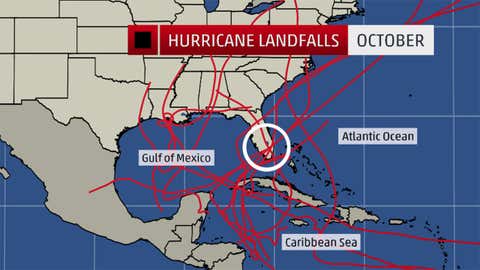Where the October Hurricane Threat Is the Greatest
The threat of Atlantic hurricanes still looms in October.
Florida is the state most likely to see a hurricane make landfall in the month of October, with the southern part of Florida most at risk. In fact, the last hurricane to make landfall in Florida was Hurricane Wilma on Oct. 24, 2005.
(MORE: Florida Hurricane-free Streak)
From 1851-2014, 32 hurricanes have made landfall in Florida in October, dwarfing the state with the next highest number of October landfalls -- Louisiana with nine.
There have been 17 major hurricanes (Category 3 or higher on the Saffir-Simpson Hurricane Wind Scale) that have made direct hits on the U.S. mainland in the month of October since 1851. Ten of those occurred in Florida.
It also becomes more difficult for hurricanes to make landfall farther north as the upper-level wind pattern changes and the jet stream slides farther south. That said, Superstorm Sandy in 2012 broke many meteorological rules of thumb.
(MORE: Where Hurricanes Come From)

Hurricane landfalls in October from 1950-2013.
The map above shows the 13 hurricanes that have made landfall in October since 1950. Eight of those occurred in Florida and you can see the cluster of lines in south Florida in particular.
"Since most significant October hurricanes come out of the Caribbean moving north, Florida can often be in the way," said Bryan Norcross, senior hurricane specialist with The Weather Channel.
Why Florida?Even though the peak of hurricane season has passed, anyone along the Gulf Coast, as well as the East Coast, needs to stay prepared for a hurricane.
On average one hurricane forms every year in October. The most hurricanes to form in October was five in 2010.

Typical origins and tracks of hurricanes in October.
The southwestern Atlantic Ocean, including off the Southeast coast of the U.S., and the eastern Gulf of Mexico are favorable areas for development in October, while the chance for storms to form in the eastern Atlantic becomes less likely. The western Caribbean Sea is also an area to watch for possible development, associated with the migration and extension of the monsoon trough from the eastern Pacific.
In 2013, Tropical Storm Karen formed over the Yucatan Channel and the southern Gulf of Mexico on Oct. 3. Hurricane and tropical storm watches were even issued along the Gulf coast, but Karen dissipated in the Gulf of Mexico before making landfall.
The Atlantic hurricane season is still alive in October, so don't let your guard down. |






